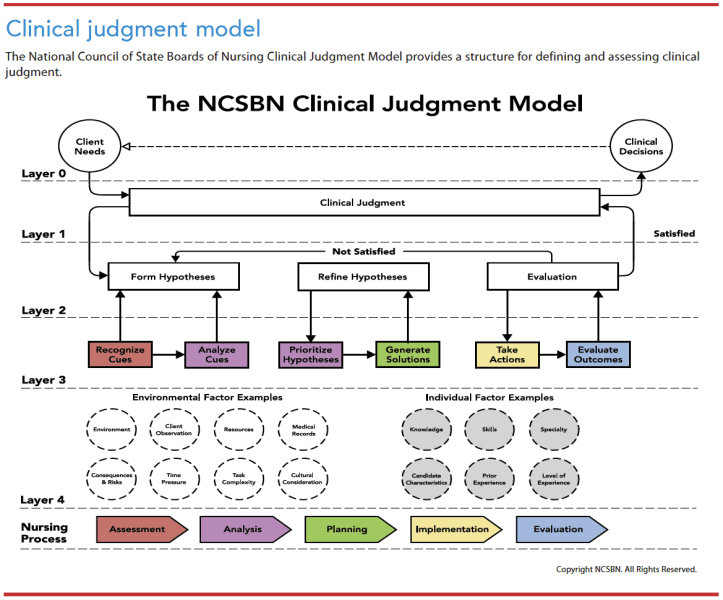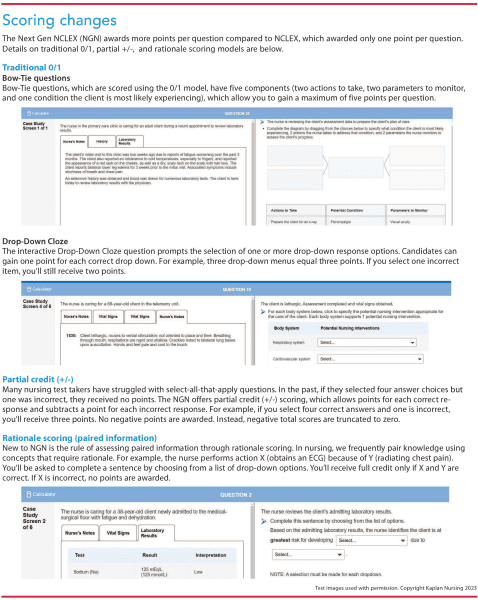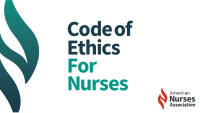Exam changes put the focus on clinical judgment, problem solving, and critical thinking.
- The main goal of the recently launched Next Generation NCLEX exam is to evaluate entry-level nurses’ clinical judgment and decision-making skills.
- The Clinical Judgment Measure Model provides a framework for defining and assessing nurses’ clinical judgment skills.
- Three evolving cases studies now included in the exam align with a cognitive operation within the Clinical Judgment Measure Model.
Research by the National Council of State Boards of Nursing (NCSBN) identified the link between clinical judgment and more than 46% of the tasks performed by entry-level nurses. Based on that knowledge and strategic practice analysis, which identified clinical judgment, problem solving, and critical thinking among the top skills required of entry-level nurses, NCSBN recently launched the Next Generation NCLEX (NGN) exam with the main goal of evaluating entry-level nurses’ clinical judgment and effective decision-making skills.
NCSBN also developed the Clinical Judgment Measurement Model to provide a framework for defining and assessing clinical judgment. Nursing educators can use this framework when developing formative and summative performance evaluations and assessments. NCSBN also uses the model to develop licensure evaluations, which, according to Dickison and colleagues ensure congruence between educational and licensure evaluations. (See Clinical judgment model.)
New nurses and clinical judgment
Enhancing nursing curriculum with an injection of technology
The judgments that nurses make every day occur in steps: recognizing and analyzing the current situation, prioritizing patient concerns, generating evidence-based solutions, and taking action on behalf of the patient. The NGN will measure these same steps by validating the development of foundational clinical judgment skills essential for safe nursing practice. During the NGN, you can apply your knowledge by analyzing realistic patient scenarios using various question types to prepare for the challenges you’ll encounter in practice.
NCLEX vs NGN: Similarities
Similar to NCLEX, you’ll have up to 5 hours to complete the NGN. The delivery method will continue to be variable-length computer-adapted testing with a total of between 85 and 150 questions, which ensures every candidate receives a unique exam. You can expect 15 unscored pretest items, which are used for future research. Familiar item types include multiple choice, select all that apply (SATA), hot spot, ordered response, and fill in the blank.
NCLEX vs NGN: Differences
NGN length has increased slightly with the minimum number of items increasing from 75 to 85 and the maximum number growing from 145 to 150 items. The NGN will begin to evaluate a pass/fail decision after 85 items rather than the traditional 75 items. NGN also will include the following new item types: Extended Multiple Response; Multiple Response–N, Matrix/Grid; Cloze Drag-and-Drop; Cloze Drop Down; Rationale; Highlight; Bowtie; and Trend.
Another major change will occur in scoring. In the past, NCLEX scored items as dichotomous—either all correct or all incorrect with no partial credit. For example, on SATA questions, if the candidate selected only three of the four correct items, they received zero points. The NGN allows partial credit.
The minimum-length test (85 items) will incorporate three evolving case study NGN sets (each case has six items for a total of 18) with traditional and clinical judgment standalone items. The probability of encountering clinical judgment standalone items (Bowtie and Trend) throughout the test, depending on test length, is about 10%.
The NGN will continue to include several multiple-choice questions, but candidates will encounter a variety of item types, including those aimed at measuring clinical judgment. To accomplish this, NCSBN will use three scoring models: traditional all or none (0/1), partial credit (+/-), and rationale. These scoring changes have many positive effects, and understanding them can boost your confidence. (See Scoring changes.)
Case studies
Three evolving case study sets with six questions (a total of 18 questions) per case present the biggest difference between NCLEX and NGN. Each case study will have a split screen with chart data to the left and standalone test items to the right. You can expect to see these questions within the first 85 items.
Each item tested in the case study aligns with a cognitive operation in the NCSBN Clinical Judgment Model. Each question will focus on a step: recognizing cues, analyzing cues, prioritizing hypotheses, generating solutions, taking action, and evaluating outcomes. A case study complete with chart data, vital sign trends, and lab tests provides an excellent format for measuring clinical judgment. You should make decisions based on your analysis of presented lab results, which will be accompanied by normal ranges (also new to NGN). This process reflects the judgments professional nurses make every day as they care for patients safely and competently.
Six takeaways
To help you prepare for taking the NGN, consider the following takeaways:
- Read item directions carefully and completely. Candidates should select exactly the number of responses directed. For example, Multiple Response-N (Select N) questions will specify the number (N) of options to choose. The scoring model is 0/1 with the maximum score designated by the N. There is no penalty for incorrect choices. After the correct number of options are chosen, other options will gray out. You can change choices by clicking and un-clicking options.
- With Matrix Multiple Choice questions, focus on the row. Each row is scored independently with 0/1 scoring; the scores for the rows are summed together. The computer won’t advance to the next question until you select an answer for each row.
- With Matrix Multiple Response questions, focus on the column. The scoring model is +/- and calculated per column. Treat each column like a SATA question, determining if the criteria are correct or incorrect. However, it’s possible that a row won’t meet any criteria. You can leave a blank row, but not a blank column. The computer won’t advance to the next question until you select at least one answer per column.
- Take your time. You have 5 hours to complete the exam with two optional breaks (the first 2 hours into testing, and the second after 3.5 hours). You should expect to need all of that time. Slow and steady wins the race.
- Be patient. The NCSBN will send official results about 6 weeks after the exam. However, many states participate in a Quick Results service in which, for a modest fee, you can receive results in 2 business days.
- Use NCSBN resources to practice. You can access a list of free preparation resources from NCSBN. (See Resources.)
Success requires perseverance
The NGN presents an exciting new challenge by mimicking the lifesaving decision making required of bedside nurses, who make complex critical judgments that require careful problem solving. Nursing educators prepare students to follow the nursing process, make decisions based on factual textbook information, and to prioritize patient safety. This is an excellent foundation upon which to make clinical judgments and thus manage the NGN. However, success will come only to those who study. Create a strict study schedule. You’ll achieve success with hard work and perseverance.
Resources
The National Council of State Boards of Nursing offers free online Next Gen NCLEX (NGN) study resources.
- 2023 NCLEX Examination Candidate Bulletin: Comprehensive document of the entire testing process. nclex.com/files/2023_NCLEX_Candidate_Bulletin.pdf
- NEXT-Gen NCLEX sample pack: Free download, including 64 pages of RN case studies and all new item types. To take this exam, candidates must accept the license agreement on page 1 and proceed. ncsbn.qualtrics.com/jfe/form/SV_3vCOaqQakTbaOwu
- NEXT-GEN NCLEX Tutorial: Overview of the Pearson Vue Exam Software. To take this tutorial, click on the “Watch Tutorial” link under the laptop icon on the site. pearsonsvue.org/ncsbn/nclex-tutorial.html
- NGN exam preview: Free download with 130 sample items, including challenging case studies. ncsbn.az1.qualtrics.com/WRQualtricsControlPanel/File.php?F=F_bpBwY7Is4EoRiWa
Sharon Hudacek is a professor of nursing emerita at the University of Scranton in Scranton, Pennsylvania. Elissa Wagner is a nurse educator consultant at Kaplan North America in Michigan.
American Nurse Journal. 2023; 18(11). Doi: 10.51256/ANJ112342
References
Dickison P, Haerling KA, Lasater K. Integrating the National Council of State Boards of Nursing Clinical Judgment Model into nursing educational frameworks. J Nurs Educ. 2019;58(2):72-8. doi:10.3928/01484834-20190122-03
National Council of State Boards of Nursing. 2023 candidate bulletin. ncsbn.org/publications/2023-nclex-candidate-bulletin
National Council of State Boards of Nursing. Next Generation NCLEX News: Approved NGN Item Types. 2019. ncsbn.org/publications/ngn-news-fall-2019
National Council of State Boards of Nursing. Next Generation NCLEX News: Examinations Analysis and Research. 2018. ncsbn.org/publications/ngn-news-winter2018
National Council of State Boards of Nursing. Next Generation NCLEX News: Scoring Models. 2021. ncsbn.org/publications/NGN-News-Summer-2021
National Council of State Boards of Nursing. Next Generation NCLEX News: Test Design. 2022. ncsbn.org/publications/ngn-news-winter-2022
National Council of State Boards of Nursing. Strategic Practice Analysis. 2018. ncsbn.org/publications/Strategic-Practice-Analysis
National Council of State Boards of Nursing. Test plans. 2023. ncsbn.org/exams/testplans.page
Key words: NCLEX, Next Generation NCLEX, NCLEX changes, clinical judgment, Clinical Judgment Measurement Model




















